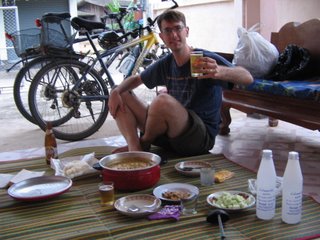We have learned to interpret the recommendations of the Lonely Planet guidebook series with some skepticism. Their descriptions of lodging and food, though never entirely off the mark, will often have some error or omission that we'll wish we had known about sooner. Their listing of "Indian Restaurant Vegetarian Food" in Chiang Mai, however, was right on.
We arrived in Chiang Mai after dark on Friday evening. Hungry for some cheap but moderately healthy food, we called over to the restaurant to make sure they were open. "Oh, yes, come on in," they said. "What time do you close?" we asked. "Oh, whatever time is good for you," the woman replied.
We walked the short distance from our guest house to the restaurant. Located on a busy but quiet lane with many shops catering to the backpacker tourist crowd, Indian Restaurant Vegetarian Food looks like a small cafeteria with about 6 or 7 tables. Bollywood music videos were playing on the television, and the white walls were decorated with an assortment of Thai and Indian posters. Only one table was already occupied when we arrived, but by the time we left an hour later they were all full. A stout gentlemen with grey-black hair brought us our menu. "Are you hungry?" he asked. "Yes, we're very hungry!" we replied. I ordered some samosas to start.
The all-vegetarian menu contained all the standard curries, with a few additional options. We decided to each order a "thali" -- a selection of curries with rice and flatbread. When the stout gentleman arrived with our samosas, he was ready to take our order. "So you'll be having a thali and a dosa?" he asked. "No," we said, "we each want a thali." "Ok, a thali and a dosa, big for you to share," he continued. We looked at each other. "No, we don't want dosa. Just two thalis," we tried again.
"Oh, two thalis!" he answered. "Ok. So you will have some lentils, some paneer, and some capsicum curries?"
"Well, can we choose our own curries?" we asked hesitantly.
"Choose, ok."
"I would like lentils, chickpeas..." Robert started.
"No chickpeas. How about capsicum?" said the gentleman.
"Err... how about these potatoes and peas?" tried Robert. "And some potatoes and tomatoes?"
"Ok, and one more," said the man. "You want capsicum?"
"How about potatoes and paneer?" Robert asked.
"Potatoes potatoes potatoes!" exclaimed the gentleman. "All you are eating is potatoes!"
"I like potatoes," Robert replied.
"Ok," the gentleman turned to me, "and you will have four different curries that I will choose for you?"
"Well, I would like dahl too," I started.
"Ok, dahl too," he replied, "and capsicum?"
Capsicum (bell pepper) curry didn't sound very appealing to me, no matter how much he was pushing it. "Can I have yellow pumpkin?" I asked.
"Ok, he said." "And capsicum?"
"And how about spinach and paneer?" I continued.
"Ok, and then capsicum?"
I gave up. "Ok, I'll try the capsicum." I said. We ordered two mango lassis and dove into our samosas as soon as he was gone. They were outstanding, though better on their own than with the accompanying sauce.
While waiting for the arrival of our thalis, we watched the woman in the kitchen, presumably the wife of the gentleman who took our order, juggle the various pots and pans on the stove. It seemed to be very much a family operation.
When the food came, we were not disappointed. The dahl was fantastic. Although there were a few changes from what we remembered ordering (we both ended up with capsicum), everything was delicious. The individual flavors in each curry stood out well, especially the yellow pumpkin. The flatbread was good, and the rice was an aromatic variety I haven't seen in Thailand. The mango lassies were refreshing and not too sweet.
At the end of the meal, our total bill -- including samosas, 4 scoops of curry apiece, rice, flatbread, water, and mango lassis -- came to just 290 baht, or about $7.50. We were impressed. Completely stuffed, we walked back to our guesthouse and vowed to return to the gentleman's Indian restaurant as often as possible. If he pushes the capsicum, we may take him up on it again.
To get to Indian Restaurant Vegetarian Food, enter Soi 9 off Moon Muang Road (along the moat). A short walk down the soi, the Local pub will be on your right. Turn left to walk away from it and you'll see the big white free-standing sign listing cheap Indian vegetarian foods.














